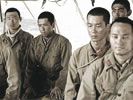Eye For Film >> Movies >> Letters From Iwo Jima (2006) Film Review
What is it about this flat, bare island that became so important during the Pacific campaign of 1944? Why didn’t the US fleet sail straight past and leave the enemy garrison to fend for itself on Iwo Jima, with no one to fight? Director Clint Eastwood didn’t address these questions in Flags Of Our Fathers and he doesn’t now.
Letters is the flip side of Flags and is generally considered to be the better of the two. Although conducted entirely in Japanese, with the odd English speaking flashback to ease pressure on the subtitles, the film’s construction feels unnaturally American. Perhaps, this reflects the contribution of co-writer Paul (Crash) Haggis.

When General Kuribayashi (Ken Watanabe) arrives on the island to take over from an ineffective old buffer, who did everything by the book, or didn’t do it at all, things are going to change. This man is a star in every respect and looking at it now, in hindsight, it seems crazy that the Japanese high command was prepared to sacrifice such a fine officer on what it knew to be a suicide mission.
Like in any army, there are good soldiers and bad soldiers and Japan has always had a lousy press because of the treatment of prisoners and other cruelties. The appalling massacre of innocents at Hiroshima and Nagasaki is seen by many as a cleansing of the nation’s sins. Eastwood goes out of his way to compensate by showing these men to be as human as you, or I. In fact, in some cases, they display a decency and courage that goes beyond the call of duty.
Where the film apes Hollywood is by choosing a handful of characters and concentrating on their stories and, if necessary, using flashbacks to fill in personal details. This brings you closer to their emotional core and makes you care whether they live, or die. It also sentimentalizes what is, after all, a terrible memory.
By the time the American navy, stretching to the horizon, arrives, the small Japanese force has dug cave defenses and tunnels in the rock and is ready to fight to the last man.
Cleverly, Kuribayashi leaves the beaches open and allows the GIs to fill them before opening fire from his position in the cliffs. But he learns shortly afterwards that the Imperial fleet has been destroyed and there will be no reinforcements. He and his men are isolated, outnumbered, and short of food and ammunition. There is nothing left but to “die with honour,” which is something the Japanese do well.
The film is shot almost entirely without colour. When the battle starts, the blaze of fire from the big guns comes as a shock, emphasizing the hellish power of these killing machines. The acting, at every level, is exemplary and if the script allows itself the comfort of flashbacks to soften the reality of violent death, so be it.
Eastwood’s twin tribute to those who gave their lives on Imo Jima is an indictment against nations and leaders who believe that war is anything other than an obscenity.
Reviewed on: 22 Feb 2007




















